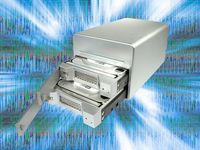Benchmarking With Intel's NAS Toolkit

Exploring NAS
Network Attached Storage (NAS) units—storage solutions with network interfaces—are already popular at work and becoming much more mainstream at home, too. Manufacturers are trying sell NAS devices for every user type, which means that there are many choices available. The range stretches from simple units with just a single drive, right through to units with two, three, or more drives, and even to large NAS servers with full-scale PC hardware inside them.

In addition to plenty of capacity, many NAS boxes come armed with additional functions, like the ability to share multimedia files via Universal Plug and Play (UPnP). Thus, they can serve up the entertainment to Home Theater PCs (HTPCs) on the network without requiring those machines to have their own massive hard drives.
The differences between network storage devices is considerable, however, and not all of them provide sufficient performance. Many of those differences have less to do with software than speed and data security. Units with just a single hard drive do not, for example, offer protection against the failure of a disk and subsequent data loss. Units containing several drives offer a greater degree of security, but may under some circumstances sacrifice performance versus similar devices made by other manufacturers.
Buying NAS With At Least Two Drives
Network storage units that support several drives usually include RAID functionality, regardless of whether or not the manufacturer advertises it. This technology lets you combine several physical drives into a logical drive where the individual devices contain redundant information about the data stored. Should one of the drives develop a problem, depending on the RAID mode selected, the data will still be available on the other drives.
The RAID level of choice determines how redundancy happens on the NAS. RAID 1 describes the mirroring of data from one physical drive to a second drive. It is the simplest method of redundantly storing data. The prerequisite for the operation of a RAID 1 configuration is at least two physical drives.
Another popular RAID version is RAID 5. The prerequisite for this level is at least three drives. Unlike RAID 1, in a RAID 5 configuration, the blocks of data are not mirrored one to one on all the drives, but distributed across them. In addition to this distribution, parity information is written to the drives. In the event of one of the drives failing, this parity information enables the recovery of the data blocks stored on the defective drive. The parity data is calculated using a function called exclusive or (XOR).
Stay on the Cutting Edge
Join the experts who read Tom's Hardware for the inside track on enthusiast PC tech news — and have for over 25 years. We'll send breaking news and in-depth reviews of CPUs, GPUs, AI, maker hardware and more straight to your inbox.
-
malveaux Heya,Reply
Nice. Intel released benchmarking software for NAS... NAS?!?! And they wont let it work on AMD cpu's?
Weaksauce.
Cheers, -
smelly_feet To Toms Hardware:Reply
Please add powerconsumption in all your benchmarks (at the wall). The only reason for me to buy a NAS (over a miniitx) is powerconsumption and heat generated. -
malveaux Hrm,Reply
I too am interested in that Smelly_Feet.
As it is, I use an older computer with some drives in it running FreeNAS. I have no real reason to look into stand-alone-options. If however there are things that use less energy all the time, I'd be tempted to switch things around.
Cheers,
Most Popular


